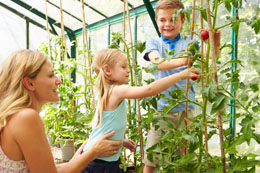Many vegetables are easy to grow and by learning to plant a vegetable garden in a small space you can grow many herbs and vegetables, and use these fresh vegetables for cooking.

The job of creating a garden needs some planning and research. The two important questions to ask is 'what to plant' and 'when to plant'. By figuring out the right plants and the right time to plant them, you have completed an important step in starting a vegetable garden. It is important you consider plants which are compatible with each other, which means they don't inhibit each other's growth. Also, figure out what is the right time to plant these crops. Make groups of plant according to the season, as they should be planted and grown together. Here are useful tips and tricks that will help you plant different kinds of vegetables.
Selecting the Site
The best way to plant a garden is to select a site which is the sunniest and brightest in the yard. If you can't find such a spot then find the next sunniest spot, however, avoid any areas which are too shady as only leaf crops can grow in limited sunlight. If you don't have enough space in your yard, then make groups of plants which can be grown on a patio or deck using container gardening. Many hanging plants which can grow on limited sunlight are a great choice.
Choosing the Right Plants to Grow
As this is your first time growing a vegetables garden, pick lesser than average number of seeds of the vegetables, so that you don't run out of space. Select the varieties that grow, mature, and yield to the region and pick seeds of vegetables that you and your family would like to eat. If you are in doubt then seek advice of a local master gardener or a certified plant nursery professional.
Timing the Plantation
It is important that you pick the vegetables according to the season. Vegetables which come earliest in spring season are rhubarb, lettuce, asparagus, and radish. Vegetables that you can store in your basement and grow in winters are potatoes, carrots, squash, parsnips, etc. For summer sweet corn, beans, peas, beets, cauliflower, and tomatoes are appropriate. So do a little research on the vegetables which can be grown in the respective season and pick the vegetables which you and your family would like to eat.
Preparing the Soil
Once you have made the selection of vegetable seeds, prepare the soil. Add generous amounts of organic humus to the existing soil. Peat moss and compost are good forms of organic humus, which can be added to the existing soil. Then mix the humus thoroughly in the soil and you are ready to begin the planting.
Planning the Layout
The planning should be done considering two important factors. First is to plant the crops which don't inhibit each other's growth, and the second important factor is to allow appropriate space between each group of vegetables and keep appropriate space between each individual plant. Plant the medium-sized crops like cauliflower, broccoli, tomatoes, squash, pumpkins, cabbage, etc., in the middle of the garden. Then at the very southern-end you should plant the low-growing crops like carrots, beets, lettuce, onions, radishes, etc. Form trays for groups of vegetables and plant the groups in these trays. To understand the individual distance between the plants, refer to the seeds packages. The seed packages will tell you the exact distance that needs to be maintained between seeds while planting.
So, use the above guidelines and make the right selection of vegetables to start your very own vegetable garden!






 The job of creating a garden needs some planning and research. The two important questions to ask is 'what to plant' and 'when to plant'. By figuring out the right plants and the right time to plant them, you have completed an important step in starting a vegetable garden. It is important you consider plants which are compatible with each other, which means they don't inhibit each other's growth. Also, figure out what is the right time to plant these crops. Make groups of plant according to the season, as they should be planted and grown together. Here are useful tips and tricks that will help you plant different kinds of vegetables.
The job of creating a garden needs some planning and research. The two important questions to ask is 'what to plant' and 'when to plant'. By figuring out the right plants and the right time to plant them, you have completed an important step in starting a vegetable garden. It is important you consider plants which are compatible with each other, which means they don't inhibit each other's growth. Also, figure out what is the right time to plant these crops. Make groups of plant according to the season, as they should be planted and grown together. Here are useful tips and tricks that will help you plant different kinds of vegetables.